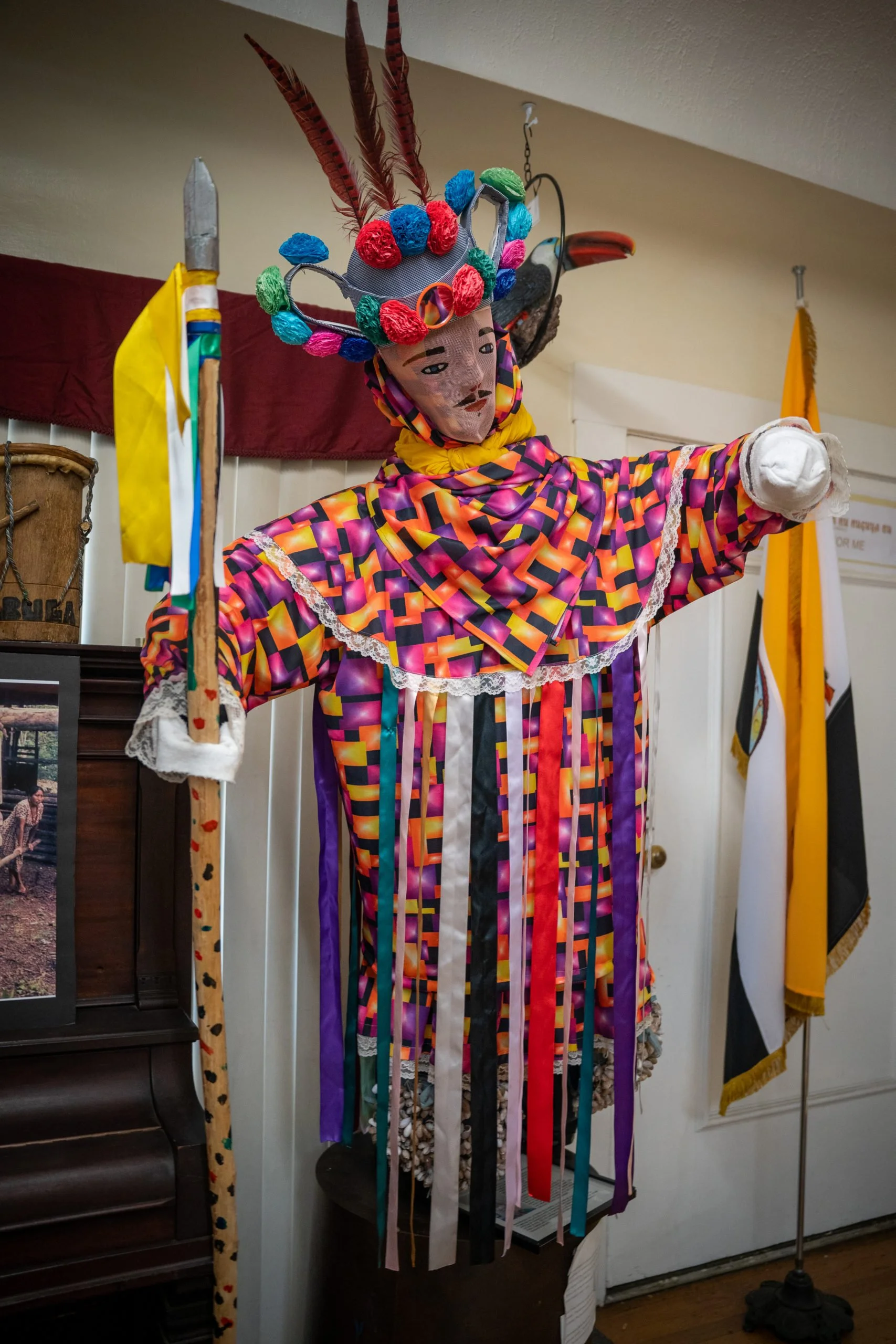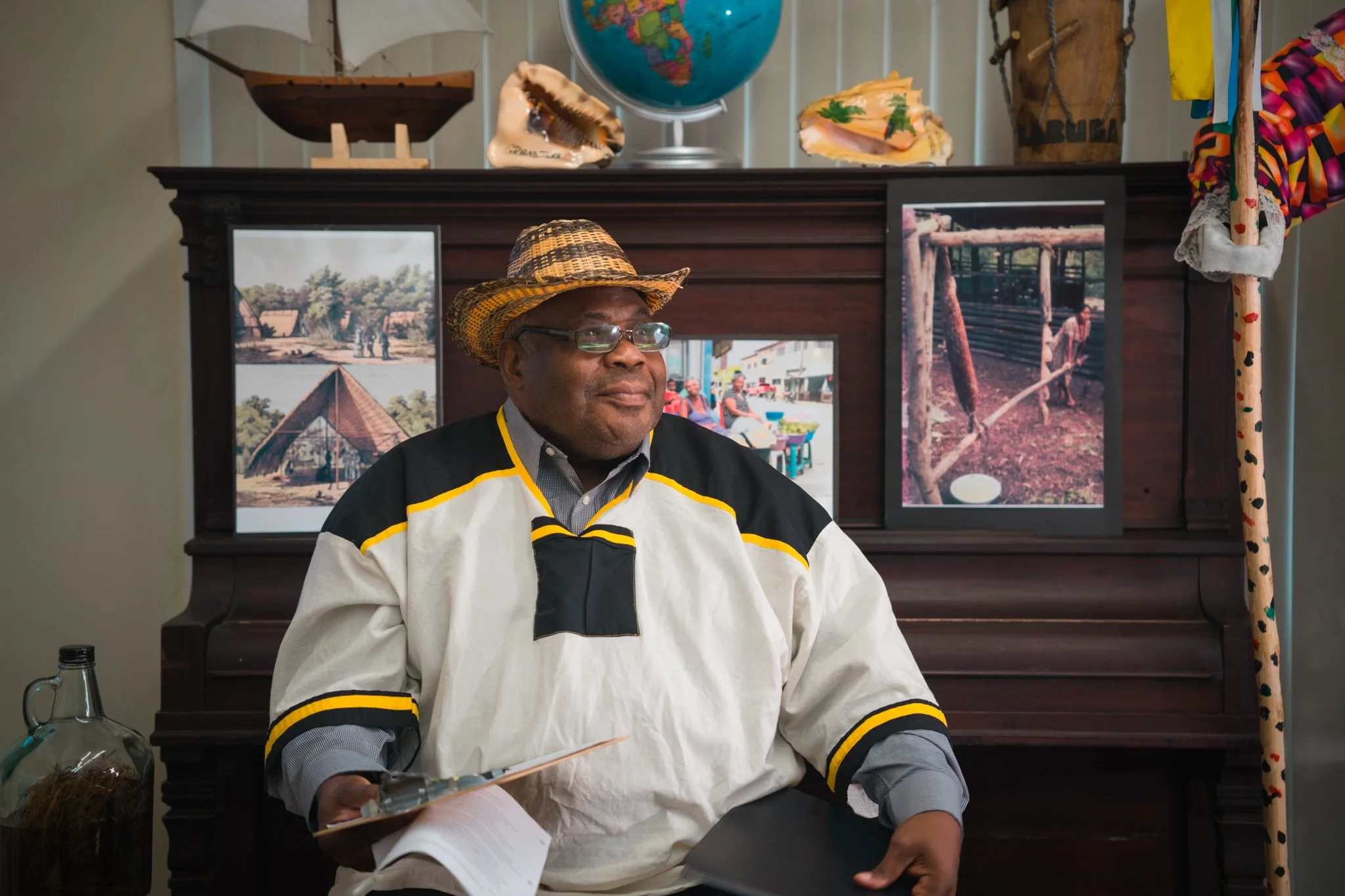How This Cultural Center Preserves Garifuna History in Los Angeles and Beyond
On a rather quiet residential block sits a museum, blending in with its surroundings. As a matter of fact, you might question if you were at the right location if it weren't for the sign that evokes the colors of the Garifuna flag—black, white and yellow—and reads “Garifuna Museum of Los Angeles." Enclosed in the “G” is an illustration of a wanáragua dancer with its signature white face mask.
Upon entering the museum at 1523 W. 48th St. in Los Angeles, CA, Cynthia Lewis—a tour guide and well-known face at GAMOLA—warmly greeted a colleague and me. Lewis, who is Garifuna and has volunteered at the museum since 2018, instructs us to sign in, and soon after, our nearly two-hour journey into the history, culture and impact of the Garinagu (the plural version of the term “Garifuna”) begins.
In 2011, the Garifuna Museum of Los Angeles, also known as GAMOLA, opened the doors to its South LA space. Rubén Reyes––with the support of The Blazers, its founder Bennie Davenport and members of the Garifuna community––set out to create a museum to preserve Garifuna culture. Of particular importance was establishing a space where Garinagu—especially of younger generations—could see themselves reflected in the artifacts displayed. It’s fitting for a city like LA that is home to roughly 100,000 Garinagu.
“There was not a place, a physical place, where you can go and enjoy the tangible items of our culture,” says Reyes, who was born in Tela, one of many Garifuna towns on the Caribbean coast of Honduras. “[GAMOLA] is that unique place so far in the United States.”
As a Bronx, New York-born Garifuna, I connect with Reyes’ words as I reflect on the living archives found in my parents’, grandparents’ and other relatives’ homes in both the U.S. and Honduras. Cultural traditions—including food (like hudutu, darasa and gadamalu), language, dance (think: punta) and music—served as my earliest recollections of my Afro-Indigenous roots. GAMOLA's collection is similarly composed of objects that relate to cultural traditions preserved in domestic spaces. In fact, Reyes and his sister brought kitchen tools back from a trip to Honduras as some of the first items to display at the museum. Used for processing cassava, an egi¹, like the one I first saw during ereba-making on a visit to Honduras, was among the items shown in the artifacts room, as well as an original ruguma². They also brought back musical instruments, like maracas, or sísira (in Garifuna).
While cultural spaces and temporary exhibitions have showcased Garifuna culture outside of our “homes” in cities like New York, Chicago and New Orleans, GAMOLA is rare in that it is a dedicated place designed to archive our existence.
Carefully curated, each item in the museum aims to teach visitors about the centuries-old existence of the Garinagu. On a wall, a visual timeline—labeled in both English and Spanish—outlines one account of Garifuna history, walking visitors through the origin of Arawaks and Caribs and how they mixed with shipwrecked Africans to become Garinagu (or Black Carib) in Yurumein, or St. Vincent and the Grenadines, to being forcibly exiled and arriving in our ancestral homelands of Belize, Guatemala, Nicaragua and Honduras. In the back of the main room, a carefully drawn-out map marks the Garifuna territories across Central America, labeling each by its original name.
This was the first time I had ever seen the names of my family’s hometowns—Ciriboya and Iriona Viejo—written in Garifuna on a map. During my trip to Honduras in June, I used the signs of the towns as markers to show proximity to our beloved tierra. Once our bumpy venture hit Cusuna, the green and white signs only meant one thing: the sweetest embrace from family was minutes away. I couldn’t resist taking a photo in front of the map—a popular photo opportunity, as evidenced by GAMOLA’s social media pages—so I could revisit that moment. Of course, I also wanted to proudly show my parents their towns (as it was a first for them, too). The museum’s ability to dissolve national borders and center Black Indigeneity is powerful. Whether a person is a Garifuna descendant or just learning about this vibrant culture, there is at least one part of the museum that will resonate with them.
“You can go and take a look at books written by Garifuna people—or about Garifuna, or their ancestry as far as being Carib, Arawak and African. The emphasis is in Garifuna itself,” Reyes says. “We do have [an] exhibition of the art of many Garifuna from different places to show that there are Garifuna artists—and they are good ones, too. We have a wall of heroes where children can see that Garinagu have outstanding people that [have] done great things.”
GAMOLA shines a light on all areas of Garifuna life through artwork, articles, books, directories, maps, media and language classes, among other things. At one time, the community-centered institution offered in-person and virtual Garifuna classes. While the museum fills each room with cultural items, there are more artifacts than available space. However, GAMOLA is showing no signs of slowing down; in fact, they’ve grown to a team of six volunteers and hope to expand further in the future.
For now, their small but mighty team is giving tours by appointment and sharing visitor experiences on Instagram.
“I want our people to come to the museum to keep it going because we’ve got so much to give from each country that we're in,” Lewis says. “Come to GAMOLA.”
For more on Garifuna culture, read:
¹ A handmade grater used when making cassava, or ereba, bread.
² A long, woven, man-made strainer used during the cassava-making process. It ensures the toxins are squeezed out of the cassava.
Janel Martinez is a multimedia journalist & the founder of award-winning blog Ain't I Latina?, an online destination celebrating Afro-Latinx womanhood. The Bronx, NY, native holds a BA in Magazine Journalism & Sociology from Syracuse University. Her writing has appeared in Adweek, BuzzFeed, ESSENCE, Oprah Magazine, & Remezcla, among other publications. She is a frequent public speaker discussing media, culture & identity, as well as diversity at conferences & events for Bloomberg, NBCU, SXSW, Harvard University & more. Her work is included in the anthology, Wild Tongues Can't Be Tamed, published by Flatiron Books.



